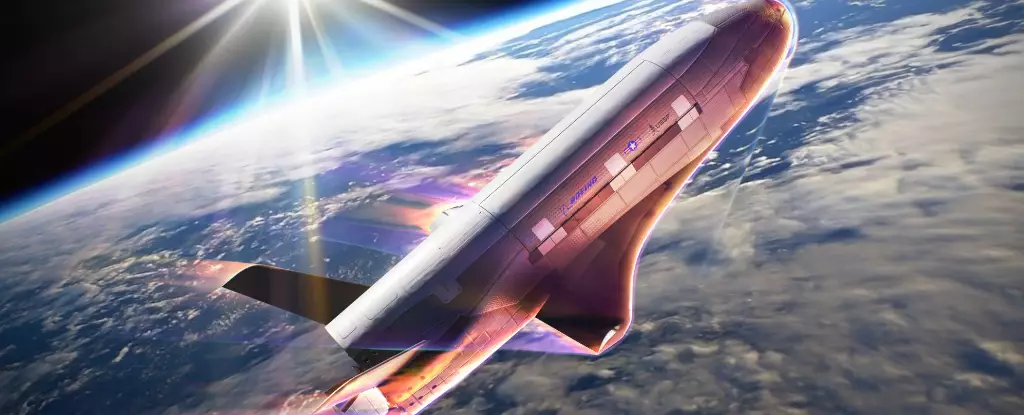Since its initial launch in 2011, the X-37B Orbital Test Vehicle (OTV) has intrigued and puzzled the public and experts alike. Designed and built by Boeing, the OTV is a re-usable space plane operated by the U.S. Space Force (USSF). It operates at altitudes ranging from 240 to 800 kilometers (approximately 150 to 500 miles) above the Earth. The primary goal of the X-37B is to test cutting-edge technologies that could pave the way for future long-term missions in space. With its latest venture, OTV-7, starting on December 29th, 2023, the X-37B continues to be a focal point of innovation and secrecy in military space initiatives.
The seventh mission of the X-37B is particularly notable for its focus on exploring the effects of space radiation and developing Space Domain Awareness (SDA) technologies. This ambitious mission goes beyond previous undertakings by integrating a series of groundbreaking maneuvers designed to adjust its orbit around Earth. This innovative tactic, known as “aerobraking,” involves the vehicle skimming the upper atmosphere to decelerate and plunge into a lower orbit without burning substantial fuel.
This method isn’t just a unique application for the X-37B; it draws from historical precedent, including successful maneuvers performed by missions to celestial bodies such as Mars. The Mars Global Surveyor and several other orbiters have utilized similar strategies to optimize their trajectories, demonstrating the gradual evolution of aeronautical technology in space exploration.
The introduction of aerobraking capabilities represents a influential leap forward for the USSF. By successfully executing this technique, the X-37B can operate in lower orbits while remaining undetected by potential adversaries, thus enhancing its strategic and tactical positions. Such stealthy operations allow the U.S. to gather essential intelligence while complicating the tracking efforts of other nations. According to USSF officials, these maneuvers reflect a deep commitment to innovation and assure the United States’ technological superiority in an increasingly competitive space landscape.
The X-37B’s first-time use of aerobraking may signal a shift in how the U.S. conducts surveillance and reconnaissance in space. By regularly altering its orbit, the OTV could confuse adversarial tracking efforts, making it more challenging for other nations to anticipate its movements.
Despite its extensive operational history, much about the X-37B remains cloaked in secrecy. During the Aspen Security Forum, former USAF Secretary Heather Wilson highlighted how the spacecraft’s unique orbit can intentionally avoid detection, noting how this feature frustrates potential adversaries. This “egg-shaped” orbit strategy allows the X-37B to maneuver in ways that keep its operations under wraps, increasing the difficulty for rival nations to predict its next moves.
Jonathan McDowell, a Harvard-Smithsonian astronomer, further elaborated on this point, discussing the complexity introduced by the vehicle’s atmospherics-dipping movements, which disrupt the predictable orbital patterns usually used for tracking. The psychological impact on adversaries cannot be overlooked; uncertainty in tracking leads to hesitation in response decisions, strengthening the U.S.’s advantage.
Beyond its innovative maneuvers, OTV-7 is designed to conduct various experiments, including the “Seeds-2” project, which studies the effects of space radiation on plant seeds provided by NASA. The data gleaned from such experiments could have profound implications for future long-duration missions, particularly concerning food sustainability for extended periods in space.
The USSF has also indicated an emphasis on responsible space operations through the decommissioning of certain service module components, adhering to recognized standards for mitigating space debris. As space becomes increasingly crowded, the commitment to minimizing orbital junk also aids the U.S. in maintaining a leadership role in space exploration ethics.
The X-37B stands as a testament to the U.S. commitment to both innovation and security in the ever-evolving domain of outer space. As it embarks on its OTV-7 mission, the implications of its aerodynamic capabilities and cutting-edge experiments reverberate far beyond the immediate venture. This unique space vehicle has transformed itself from an instrument of military exploration to a harbinger of significant advancements in aerospace technology, intelligence gathering, and strategic advantage. The future of the X-37B will likely continue to push the envelope, unlocking possibilities that could redefine space operation paradigms for years to come.


Leave a Reply